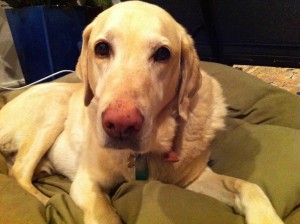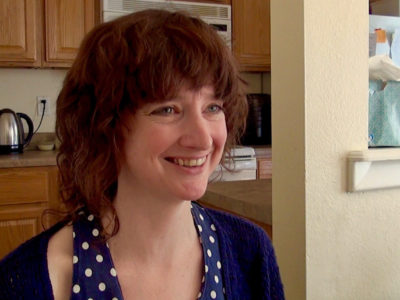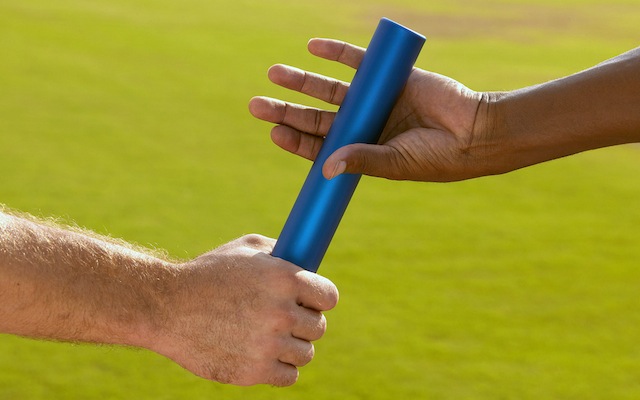- Brian’s New Diet
- In Memory of Brian
The idea of giving our 10-year old lab, Brian, a new diet, became a mission this week after I went hiking with friends on the trails above Boulder and watched in horror as Brian’s creaky joints nearly did him in.
It was our usual hike with Brian these days, a simple, easy trail that’s much different from the steep challenges he could gallop through four years ago. Bit by bit, our noble lab has gotten creakier. We rationalize it all, at least a little, saying that Brian’s genes mean he’s unlikely to be a super-long-lived lab. After all, his dad died of cancer when he was only nine. We had another lab, named Duke, who was the same age as Brian is now, but was much older in so many ways . Bad skin, bad breath, creaky everything but sweet as an angel, so naturally we wanted Duke to live forever. He didn’t, but he’s our yardstick for what to expect with Brian. When Duke was Brian’s age, he was much less able to be out with us on trails. And Brian — except for that creakiness and just a shadow of cloudy film in his eyes, you might mistake him for a much younger dog. That’s what we’ve been telling ourselves. Though we know that he’s getting older, as Duke did, and for us, Brian’s getting older too fast.
Our vet sees Brian monthly these days to give him acupuncture needles for inflammation plus a spinal adjustment for his catywompus spine. We’ve got him on a supplement with glucosamine powder. The vet says things such as “given his age” he’s in excellent condition, though with arthritic points in his knees, in his paws . . . about everywhere there’s at least some, so the idea of operating to fix the kinks in his spine wouldn’t make much difference, because there’d be too much arthritis left over. The dog owners on the trail who swear by cortisone shots? Like many anti-inflammatory treatments, those give some short term relief but actually speed up the destruction of joints. So we do some softer things. The acupuncture, the glucosamine powder. Most of all, we take Brian out for walks like these. And we feed Brian pretty well, some great stuff such as raw meat, raw vegetables and an avocado. Fancy stuff, I know, but less fancy in terms of cost than the price of drugs and surgery which get distressingly common among older dogs. The quality of the ingredients we give Brian is high, through I have to admit we’re somewhat casual in terms of nutrient ratios. We figure that what we feed Brian is way better than average dog food. Or at least, that’s what we’ve figured in the past. As far as other strategies for helping Brian, we have a doggie ramp so he doesn’t have to leap up into our car. We choose the easier trails for our hikes, so Brian can come with us, and sniff around, and when a younger dog comes by, he can perk up, canter up like a teenager and show off, before resuming his ambling, amiable walk with us people along the trail.
Brian’s nearly fatal tumble off the trail
That’s what we were thinking, and rationalizing, before this week’s hike. Brian was keeping up, he was happy and bright. He looked great when we paused at our turnaround spot, and as he often does on these hikes, it seemed like business as usual when he sat on the edge of the trail for a little rest. Then, Brian lost his balance. Instead of quickly righting himself as he would have even a month ago, his creaky joints wouldn’t respond to him anywhere near fast enough. So there, before our very eyes, he went rolling down the hill. He rolled like a slow motion movie scene, over and over, and there was nothing we could do. The hill was too steep for any of us to dash down and pull him back. There were bushes and rocks, and rolled through and over them, as we all cried out in unison, “Oh, no!” or “Brian!” or an anguished gasp.
The next switchback was 25 feet below us, and when he tumbled onto it, Brian managed somehow to stop. As we watched helplessly from above, Brian furrowed his brow in concentration, he gave a lunge forward and finally stood up on all four legs. Giving an apologetic wag of his tail, he clumsily made his way back up to us, and we walked back down the gentle trail with him quiet and uncomplaining, and keeping up because, for his sake, we were walking slow. He seemed totally unconcerned until we got to the car. I pulled out the heavy doggie ramp that makes it possible for him to get into the back these days. Brian sat and watched, with his creaky back legs tucked under him. Once the ramp was ready, Brian furrowed his brow and lunged forward to get the momentum he needed after all that trauma, just for standing up. Except that he couldn’t pull himself into standing. He tried and he tried, but it didn’t happen. So I lifted him up onto his legs, which embarrassed him. Brian is proud of his dogginess. Back at home, Brian took a long nap. And when he woke up later, he was creaky, but mostly it was as if that tumbling spill had never happened.
Mostly. But if I look back over the last year and the last few months, he’s getting less and less able to get around.
What Makes Dogs Live Longer?
When I see people on the trails these days, I ask how old their dog is. Often, Brian seems healthier than dogs a few year younger then him. But every now and then, an owner with a perky dog will say the dog’s 15. Nobody mentions genetics, though that plays a role in dog longevity. Instead, they tell me many things, such as they’ve been lucky with the breed, or they’ve given drugs or injections or something like that. Or they’ve kept their dog thin (Brian, like many labs and people, could benefit from being ten pounds trimmer). But the comment that stayed with me the most is one woman who told me that she cut back on the protein by quite a bit. That would fit with what Ron Rosedale has mentioned regarding the MTOR pathway. So that’s the experiment that we’re going to try . . .







Thank you for sharing this. We don’t feed Brian grains either, and it does seem to make a big difference. Grains are cheap and have a long shelf life, which makes it tempting to have them stay in dog foods. Your story is a reminder that for many dogs, none at all may be better.
When my Cairn terrier turned 12, she became quite ill with neuromuscular problems. She was losing strength and balance. She urinated in her sleep. She stopped barking. She was having difficulty swallowing and chewing. She could walk only a few feet before lying down. These symptoms came on very slowly. The vet told us it was age and arthritis.
I am gluten free and many of my symptoms were similar to hers. I took all grains out of her diet and within 3 days she started to improve. Now, two years later, she is a happy, barking, jumping, running terrier. She has never regained all her strength, but she gets around well and no urinating in her sleep.
It is not only feeding her a grain free dog food but it is not letting her have any grains whatsoever.